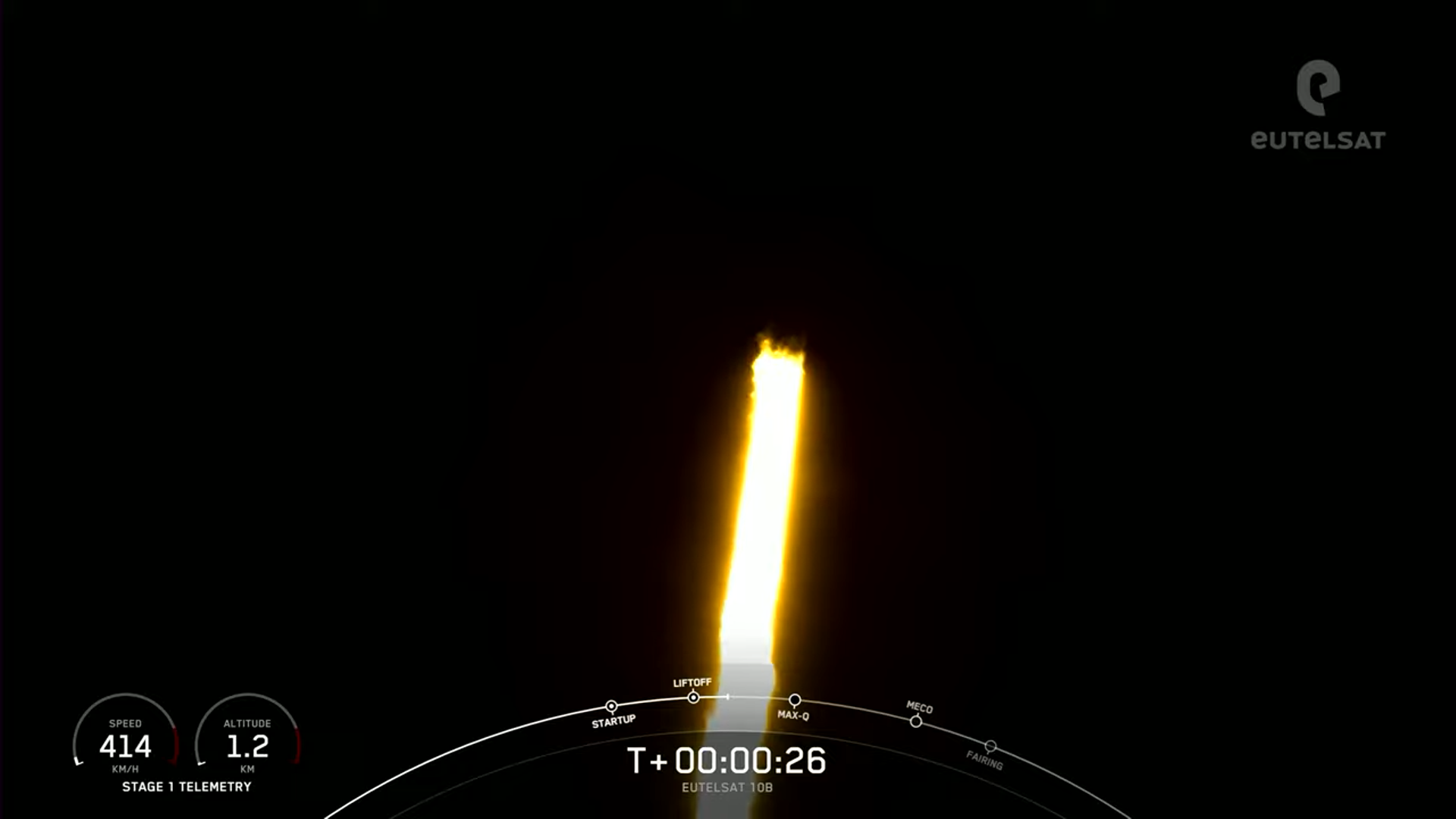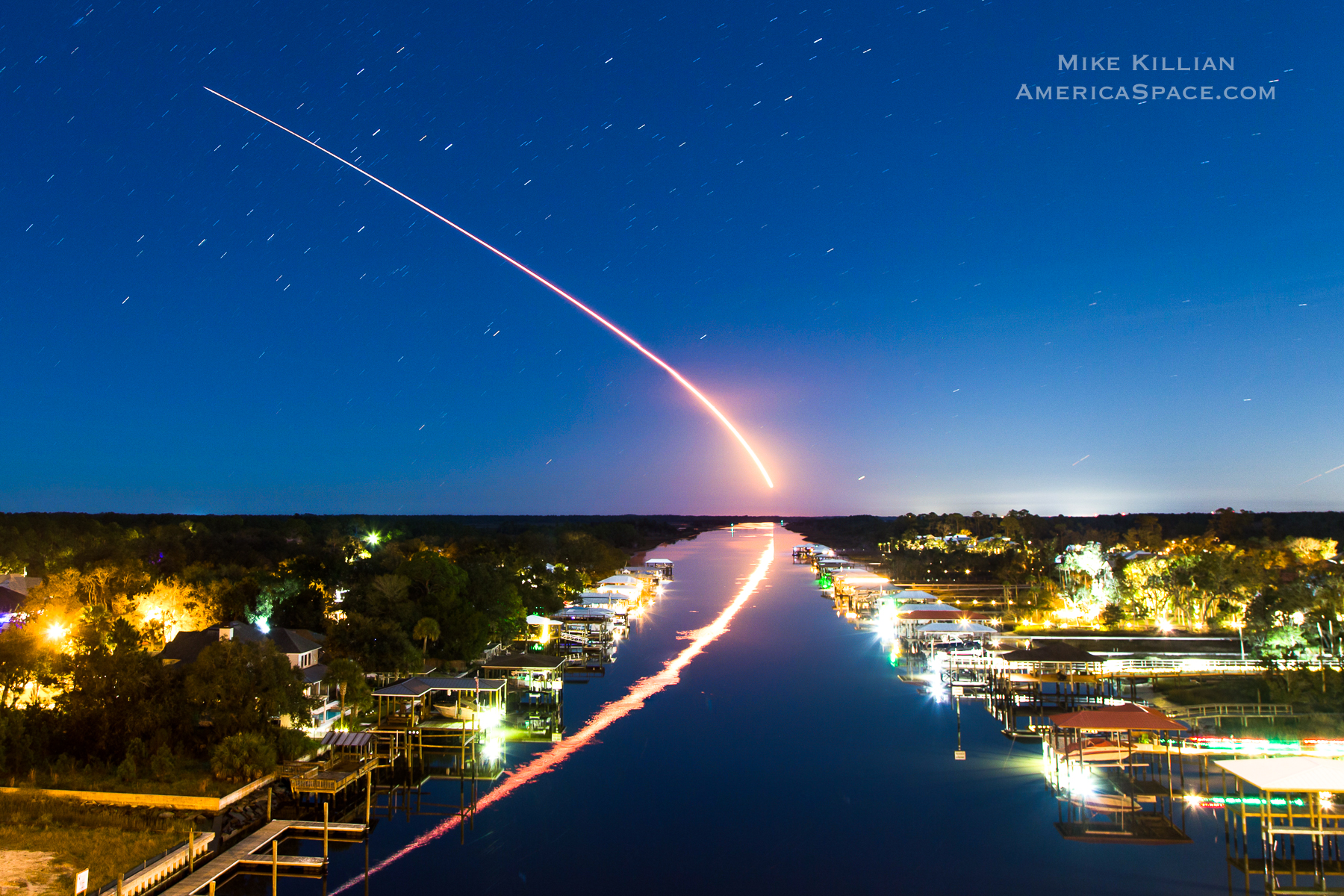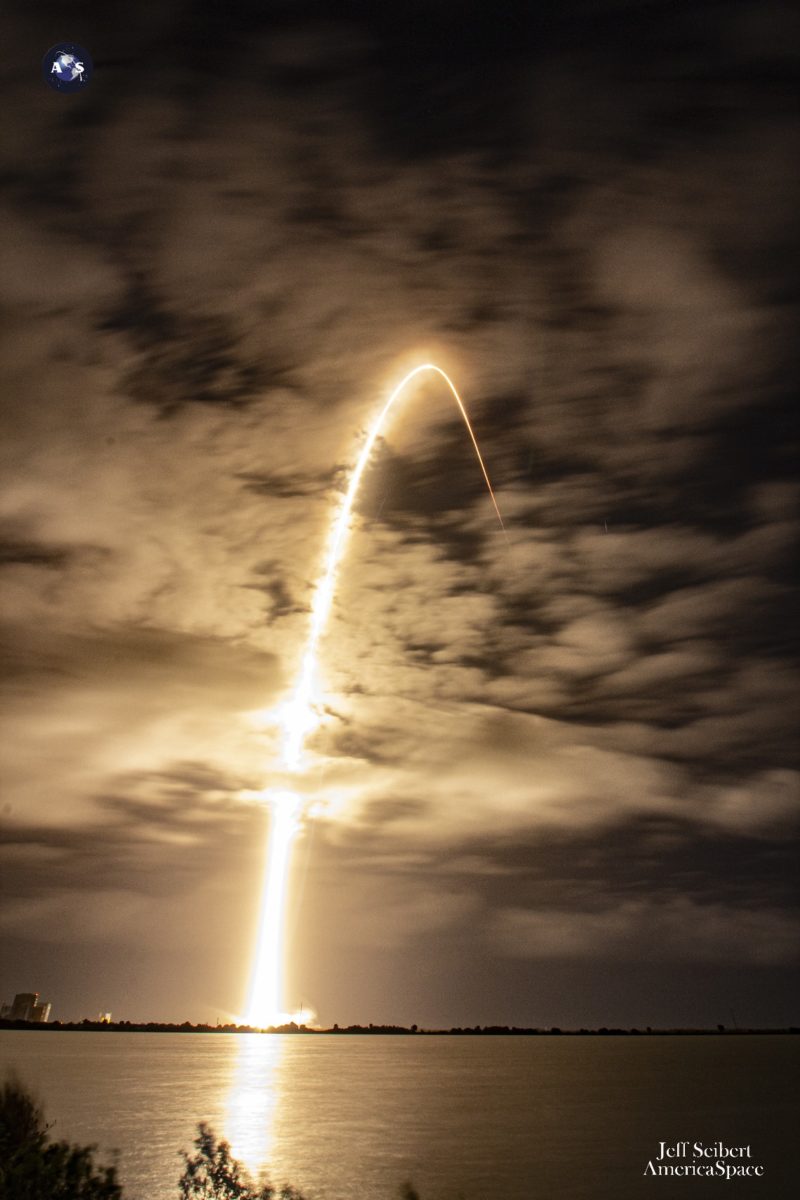
For the third time this month, SpaceX intentionally committed one of its boosters to a watery grave late Monday evening, as the 11-times-flown B1049—its longest-serving Falcon 9 core—successfully delivered the all-electric Eutelsat 10B payload for inflight and maritime connectivity on behalf of Paris, France-based communications satellite provider Eutelsat. It marked SpaceX’s eighth geostationary launch (and tenth major geostationary-bound payload) of 2022, but the performance necessary to lift the 9,900-pound-plus (4,500-kilogram) satellite required B1049 to be expended, closing out more than four years of flawless service.
Launch came at 9:57 p.m. EST Tuesday from storied Space Launch Complex (SLC)-40 at Cape Canaveral Space Force Station, Fla., only six hours after SpaceX and NASA scrubbed the launch of a brand-new Falcon 9 from neighboring Pad 39A at the Kennedy Space Center (KSC) with the CRS-26 Cargo Dragon, bound for the International Space Station (ISS). CRS-26 will now fly no earlier than 2:20 p.m. EST Saturday, 26 November.
B1049 was the fourth of SpaceX’s Block 5 fleet of Falcon 9s, equipped with a stronger heat shield, upgraded Merlin 1D+ engines, titanium hypersonic grid-fins and retractable landing legs, as well as enhanced flight controls to simplify reusability. Her three Block 5 predecessors—B1046, B1047 and B1048—had come online earlier in 2018 and by the time they retired from service in early 2020 they had logged 12 launches between them.
Astonishingly, B1049 came close to equaling their combined record all by herself. Since her maiden launch back in September 2018, a stellar career has uniquely carried her from the East Coast to the West Coast, and back again, twice.

Flying first out of Cape Canaveral, she delivered the heavyweight Telstar 18V communications satellite to orbit. She then moved to Vandenberg in California to loft the final ten-strong batch of Iridium NEXT global mobile communications satellites in January 2019.
B1049 next returned east to fly no less than seven missions between May 2019 and May of last year. And those missions lifted 418 flat-packed Starlink internet communications satellites into low-Earth, inclined 53 degrees to the equator.

Notably, this smorgasbord of flights saw B1049 enter the record-books as the first Falcon 9 core to return safely from a fifth launch and she went on to become the first to complete sixth and seventh missions. Although she was later leapfrogged in the most-flown stakes by other boosters, she remains the second Falcon 9 to have logged eighth, ninth and tenth launches and is one of only four to have flown as many as 11 times.
Following her ninth launch in May 2021, B1049 returned west to Vandenberg for the West Coast’s inaugural Starlink mission the following September. After that, she was ground-bound for more than a year, with speculation rife that she would likely be expended should an 11th mission come her way.

Her final flight is also SpaceX’s personal-best-tying eighth geostationary-bound mission of 2022, equaling with 2018. But this year has set new records by lifting ten major payloads on the first leg of their respective treks to an altitude 22,300 miles (35,700 kilometers) above the Home Planet.
Two communications satellites—Egypt’s Nilesat-301 and SES-12 for Luxembourg-based satellite provider SES—were launched in June. This was followed by a pair of Hotbird broadcasting satellites for Eutelsat, the U.S. Space Force’s highly secretive USSF-44 and a pair of dual-stacked Galaxy payloads earlier this fall.

And the year’s tenth geostationary payload, Eutelsat 10B, marks SpaceX’s third launch for Eutelsat in only five weeks. It is also her fifth overall mission for the Paris, France-headquartered satellite operator since March 2015.
This newest satellite was built by Thales Alenia Space and carries a pair of multi-beam High Throughput Satellite (HTS) Ku-band payloads. One is devoted to the North Atlantic “corridor”, emphasizing Europe, the Mediterranean basin and the Middle East, whilst a second covers the Atlantic Ocean, Africa and the Indian Ocean, to process more than 50 Ghz of bandwidth and offer a data throughput of about 35 Gbps.

Laden with a total of 36 Ku-band and 20 C-band transponders, Eutelsat 10B will be emplaced (as its name implies) into an orbital “slot” at 10 degrees East longitude. This is expected to afford it unique visibility from the Americas to Asia over an estimated 15-year operational lifetime.
“The missions will be supported by a digital 14-kilowatt multi-beam digital payload, allowing dynamic service allocation, essential to provide extensive flexibility and robustness with respect to market evolutions,” noted Thales Alenia Space. Aboard Eutelsat 10B is Thales’ SpaceFlex Very High Throughput Satellite (VHTS) fifth-generation process, “integrated at the heart of the payload”, which is expected to attain “high flexibility performance and efficiency in throughput and bandwidth”.

Eutelsat contracted with Thales Alenia Space back in October 2019 to build the satellite. Later that same month, aviation broadband internet provider Gogo leased HTS bandwidth aboard Eutelsat 10B as part of a multi-year agreement for high-speed inflight connectivity services, specifically across Europe and the Middle East.
In December 2019, Panasonic did likewise for its inflight entertainment services business—having reportedly “collaborated closely” with Eutelsat on the satellite’s design—and last year satellite services provider Overon announced a multi-transponder Ku-band contract on behalf of Eumetsat to facilitate monitoring of weather, climate and the wider environment from space.

Eutelsat 10B’s “bus” and high-powered payload were mated inside Thales’ facility in Cannes, France, last February, ahead of extensive systems and environmental testing. The satellite and its supporting equipment were transported by sea from France to Cape Canaveral last month.
With an opening launch attempt at 9:57 p.m. EST Monday, the weather outlook for the early part of the week did not look promising. According to the 45th Weather Squadron at Patrick Space Force Base, conditions for both Monday and Tuesday lingered no better than 40-percent-favorable, with a risk of violating the Cumulus Cloud Rule, the Thick Cloud Layers Rule and the Disturbed Weather Rule.
It was noted that Monday evening’s instantaneous launch attempt would be characterized by “extensive cloud cover, isolated showers and gusty easterly winds”. On Tuesday, this unsettled picture was predicted to remain in place, with some relief in the form of “opportunities for short-lived breaks in the weather”.
B1049 powered uphill for the last time from storied Space Launch Complex (SLC)-40 at Cape Canaveral Space Force Station, Fla., at 9:57 p.m. EST Monday, her nine Merlin 1D+ engines performing to perfection on their swansong mission. The core separated from the Falcon 9 at 2.5 minutes into flight, targeting a destructive impact in the Atlantic Ocean some 535 miles (860 kilometers) downrange of Cape Canaveral.

This marked the third SpaceX booster—after the Falcon Heavy’s B1066 center core and last week’s B1051—to have been intentionally expended in November alone. All told, B1049 has launched no fewer than 481 major payloads in her 51-month operational career.
With B1049 gone, the single Merlin 1D+ Vacuum engine of the second stage ignited for a standard six-minute “burn” to pre-position Eutelsat 10B for deployment. Release of the payload occurred some 35 minutes and 28 seconds after launch, where it will begin the multi-month process of raising itself to geostationary altitude and conducting an on-orbit checkout ahead of entrance into operational service.
Up next is the CRS-26 Cargo Dragon, aboard a brand-new Falcon 9 from KSC’s Pad 39A. Originally targeted for a 3:54 p.m. EST Tuesday launch—which might have created a new record of only six hours between a pair of Falcon 9 missions—the launch was ultimately scrubbed due to poor weather, notably violations of the Thick Cloud Layers Rule, the Cumulus Cloud Rule and the Flight Through Precipitation Rule.
The mission is now scheduled to occur no sooner than 2:20 p.m. EST Saturday, 26 November, where weather conditions are predicted to be around 60-percent-favorable. CRS-26 will deliver a multitude of equipment, payloads and supplies to the ISS Expedition 68 crew, including Red Robin tomato plants for the station’s Veggie facility, a new microscope for life sciences and specimen observations and a second pair of Boeing-built ISS Roll-Out Solar Arrays (iROSAs).






4 Comments
4 Pings & Trackbacks
Pingback:يبدو الطقس مواتياً لإطلاق CRS-26 ، تم تحديد رواد الفضاء لمهام iROSA التالية
Pingback:Weather Looks Favorable for CRS-26 Launch, Spacewalkers Identified for Next iROSA Tasks - Space News
Pingback:Six-Times-Flown Falcon 9 Lofts SWOT Ocean Watcher from Vandenberg - AmericaSpace
Pingback:Bob & Doug’s Falcon 9 Makes 15th Launch, Sets New Records - AmericaSpace